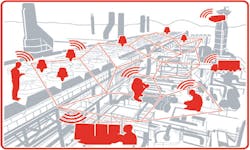When Automation World recently published its E-Book Special Report on Networks, we wanted to provide a solid overview of industrial networking technology for users in the continuous process, batch and discrete manufacturing industries that went beyond individual articles and new product announcements on the topic.
In a comment on that E-book, Martin Zielinski, director of HART and Fieldbus Technology for Emerson Process Management, said, “WirelessHART is all about making WirelessHART easy and straightforward for the end user to deploy. ISA100.11a is all about flexibility and forcing end users to make choices about a communication technology—choices that can lead to configuration mistakes and end user frustration.”
Automation World wanted to give someone representing ISA100 Wireless a chance to respond. Honeywell is one of the main vendor advocates for the ISA100.11a protocol; in March it released the availability Release 210 of its OneWireless Mesh Network product, whose features build on the ISA100.11a standard. The following comes from Soroush Amidi, marketing manager for OneWireless Products and Solutions for Honeywell Process Solutions:
“It’s important to remember user experience is defined by a product and its design, not by a standard. Honeywell, for instance, engaged its users from the onset during its ISA100 Wireless development. Their feedback resulted in an intuitive interface that allows them to deploy and configure a system within minutes—a recently conducted survey indicated more than 90 percent of our ISA100 customers were extremely satisfied with their wireless system usability.
“It is true that ISA100 is very flexible—it is a user-driven standard. More than 400 automation professionals from nearly 250 countries have offered expertise to cooperatively define and design it. The resulting standard has undergone strenuous review and has a diverse base of support.
“ISA100 Wireless had to be a comprehensive standard that met all key requirements defined by its users, but flexibility does not translate into a more complex system. It is the vendors’ jobs to make sure they implement a standard in a user-friendly manner. Honeywell invested heavily in the user experience when developing its solution, and the results paid off, as evidenced by the plus-90 percent of satisfied customers who responded to our recent survey.
“Real examples of using the communication protocol capabilities of ISA100 Wireless are found in Honeywell’s OneWireless HART Adapter, which transmits HART digital data; GE’s Bently Nevada’s wSIM, which transmits vibration waveforms for use by GE’s System 1 vibration analysis application; and GasSecure’s SIL2 approved wireless gas detector (an industry first) that transmits PROFIsafe (a functional safety protocol) messages through the ISA100 Wireless network.
“Users only need to buy the wireless variant of a field instrument from their preferred provider, put it in the field and it will join the ISA100 network. The device will send data using its native protocol (HART, proprietary, ProfiSafe) over the ISA100 network.
“The goal of ISA100 standard, as well as the WirelessHART standard, is to allow interoperability. That’s the whole point of a standard. All these devices mentioned above can communicate with each other and with an ISA100 Wireless Compatible infrastructure. There are many more ISA100 Wireless devices. Visitors to the ISA 100 both in Hannover saw all ISA100 devices communicate with each other. The list of compatible ISA100 Wireless devices is available at www.isa100wci.org
An Automation World article of mine from October 2011, Wireless Sensor Network Standards: On the Road to Convergence, provides additional background.

